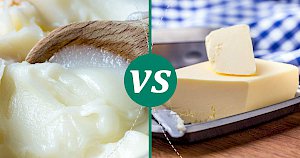Butter (60% Fat) vs Lard: Nutrition & Calories Compare


Butter 60% fat vs Lard
Nutrition Facts
Serving size:
change
5g10g15g20g30g40g50g60g80g100g120g140g160g180g200g220g250g300g350g400g450g500g600g700g800g900g1000g
1oz2oz3oz4oz5oz6oz7oz8oz10oz12oz15oz20oz25oz30oz35oz40oz50oz
Amount Per Serving:
Serving size:
change
5g10g15g20g30g40g50g60g80g100g120g140g160g180g200g220g250g300g350g400g450g500g600g700g800g900g1000g
1oz2oz3oz4oz5oz6oz7oz8oz10oz12oz15oz20oz25oz30oz35oz40oz50oz
Amount Per Serving:
Butter 60% Fat vs Lard 100g Compare
| per 100g | Butter (60% fat) | Lard |
|---|---|---|
| Calories | 499 | 898 |
| Fat | 55.1 g | 99.5 g |
| Protein | 3.3 g | 0.07 g |
| Water | 42.1 g | 0.25 g |
| Calcium | 48 mg | 1 mg |
| Iron | 1.09 mg | 0.13 mg |
| Phosphorus | 4.8 mg | 11 mg |
| Potassium | 71 mg | 15 mg |
| Sodium | 450 mg | 27 mg |
| Zink | 4.8 mg | 11 mg |
| Vitaminium A | 1698 µg | 37 µg |
| Vitaminium B1 (Thiamine) | 0.01 mg | 0.004 mg |
| Vitaminium B2 (riboflavin) | 0.07 mg | 0.015 mg |
| Vitaminium B3 (Niacin) | 0.02 mg | 0.725 mg |
| Vitaminium B6 | 0.01 mg | 0.005 mg |
When it comes to cooking fats, butter and lard hold iconic status in kitchens around the globe. Each brings its own unique flavor and texture to dishes, making them irreplaceable in certain recipes. But beyond their culinary uses, these fats have interesting stories and nutritional profiles that might influence your choice in the kitchen.
Butter: A Creamy Staple with a Rich History
Butter, particularly the 60% fat variety, is cherished for its creamy texture and rich, comforting flavor. It's made from the fat and protein components of milk or cream and has been a staple in human diets for thousands of years. Historically, butter was also used as a form of currency and medicinal salve, showcasing its valued place in society.
With 499 calories per 100 grams, this type of butter is an energy-dense food. It contains a significant amount of water (42.1%), which makes it softer and more spreadable than its fully fat counterparts. Its nutritional profile includes 55.1 grams of fat, 3.3 grams of protein, and a variety of vitamins and minerals, including vitamin A (1698 IU), calcium (48 mg), and iron (1.09 mg).
Lard: The Traditional Fat with a Modern Comeback
Lard, rendered pork fat, is making a comeback in both traditional and modern recipes. Valued for its high smoke point and ability to add a moist, tender texture to baked goods, lard has been a kitchen staple in many cultures for centuries. With 898 calories and virtually no water content (0.25%), lard is almost pure fat (99.5%), making it incredibly efficient for high-heat cooking and flaky pastries.
Though it's often maligned for its saturated fat content, lard contains less saturated fat (39 grams per 100 grams) than butter. It also provides a small amount of vitamins and minerals, including vitamin B3 (0.725 mg) and zinc (11 mg), but lacks the water-soluble vitamins found in butter.
Culinary Uses and Considerations
Butter and lard can be used interchangeably in many recipes, but the choice between them often comes down to flavor, texture, and dietary preferences. Butter's rich flavor is a key component in baking, where it contributes to the tender, flaky texture of pastries and the moist crumb of cakes. Lard, on the other hand, is praised for its ability to create supremely flaky pie crusts and for frying due to its high smoke point.
Nutritional Considerations
From a nutritional standpoint, the choice between butter and lard might depend on your dietary goals. Butter contains more water, making it lower in fat by volume, and is a good source of vitamin A and E, which are important for vision and skin health, respectively. Lard is more calorie-dense and provides a higher amount of monounsaturated fats, which have been associated with cardiovascular health benefits.
Both butter and lard contain cholesterol, with butter having slightly more (106 mg vs. 97 mg). For those watching their cholesterol intake, this might be a consideration. However, recent studies suggest that the impact of dietary cholesterol on blood cholesterol levels is smaller than previously thought, especially when compared to the effects of trans and saturated fats.
Conclusion
In the end, whether you choose butter or lard may come down to personal preference, dietary restrictions, or the specific needs of the recipe you're preparing. Both fats have their place in the kitchen, offering distinct flavors, textures, and nutritional benefits. Understanding their differences can help you make informed decisions about which to use in your cooking and baking endeavors.
Butter (60% fat) 100g
499kcalCalories source
- 0% CARBS.
- 3% PROTEIN
- 97% FAT
Lard 100g
898kcalCalories source
- 0% CARBS
- 0% PROTEIN
- 100% FAT
Compares of butter 60% fat
Compares of lard
Read also:
- Calories from Butter (60% fat)
- Calories of Dried fig
- Calories in Almond milk
- Rabbit meat calories per 100g
- Sausage protein per 100g
- How many calories does japchae have?
- Calories in a half of Merlot
- Calories in whole Merlot
- Calories for one, two or more Merlot
- Calories in glass of Merlot
- Calories in cup of Merlot
- Calories in shot (small glass) of Merlot
- How much protein in bacon cheeseburger?
Marcin Piotrowicz
calories-info.com creator
Healthy diet and healthy lifestyle promoter
Add comment